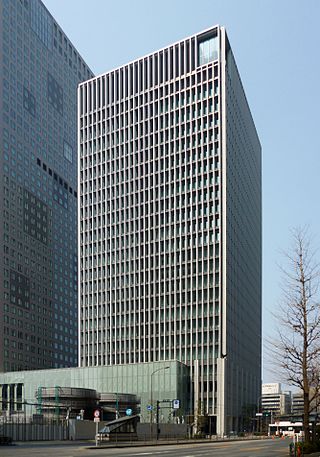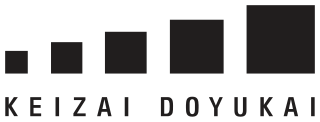Related Research Articles

A market economy is an economic system in which the decisions regarding investment, production, and distribution to the consumers are guided by the price signals created by the forces of supply and demand. The major characteristic of a market economy is the existence of factor markets that play a dominant role in the allocation of capital and the factors of production.
A mixed economy is an economic system that accepts both private businesses and nationalized government services, like public utilities, safety, military, welfare, and education. A mixed economy also promotes some form of regulation to protect the public, the environment, or the interests of the state.
The Ministry of International Trade and Industry was a ministry of the Government of Japan from 1949 to 2001. The MITI was one of the most powerful government agencies in Japan and, at the height of its influence, effectively ran much of Japanese industrial policy, funding research and directing investment. In 2001, MITI was merged with other agencies during the Central Government Reform to form the newly created Ministry of Economy, Trade and Industry (METI).

The Japan Business Federation is an economic organization founded in May 2002 by amalgamation of Keidanren and Nikkeiren, with Nikkeiren being absorbed into Keidanren.

An economic system, or economic order, is a system of production, resource allocation and distribution of goods and services within a society. It includes the combination of the various institutions, agencies, entities, decision-making processes, and patterns of consumption that comprise the economic structure of a given community.
The socialist market economy (SME) is the economic system and model of economic development employed in the People's Republic of China. The system is a market economy with the predominance of public ownership and state-owned enterprises. The term "socialist market economy" was introduced by Jiang Zemin during the 14th National Congress of the Chinese Communist Party (CCP) in 1992 to describe the goal of China's economic reforms.
Dirigisme or dirigism is an economic doctrine in which the state plays a strong directive (policies) role, contrary to a merely regulatory or non-interventionist role, over a market economy. As an economic doctrine, dirigisme is the opposite of laissez-faire, stressing a positive role for state intervention in curbing productive inefficiencies and market failures. Dirigiste policies often include indicative planning, state-directed investment, and the use of market instruments to incentivize market entities to fulfill state economic objectives.
Welfare capitalism is capitalism that includes social welfare policies and/or the practice of businesses providing welfare services to their employees. Welfare capitalism in this second sense, or industrial paternalism, was centered on industries that employed skilled labor and peaked in the mid-20th century.
The Anglo-Saxon model is a regulated market-based economic model that emerged in the 1970s based on the Chicago school of economics, spearheaded in the 1980s in the United States by the economics of then President Ronald Reagan, and reinforced in the United Kingdom by then Prime Minister Margaret Thatcher. However, its origins are said to date to the 18th century in the United Kingdom and the ideas of the classical economist Adam Smith.

Articles in economics journals are usually classified according to JEL classification codes, which derive from the Journal of Economic Literature. The JEL is published quarterly by the American Economic Association (AEA) and contains survey articles and information on recently published books and dissertations. The AEA maintains EconLit, a searchable data base of citations for articles, books, reviews, dissertations, and working papers classified by JEL codes for the years from 1969. A recent addition to EconLit is indexing of economics journal articles from 1886 to 1968 parallel to the print series Index of Economic Articles.
Social welfare, assistance for the ill or otherwise disabled and the old, has long been provided in Japan by both the government and private companies. Beginning in the 1920s, the Japanese government enacted a series of welfare programs, based mainly on European models, to provide medical care and financial support. During the post-war period, a comprehensive system of social security was gradually established. Universal health insurance and a pension system were established in 1960.

The Japanese economic miracle refers to Japan's record period of economic growth between the post-World War II era and the beginning of the global Oil Crisis (1955-1973). During the economic boom, Japan rapidly became the world's third-largest economy, after the United States and the Soviet Union. By the 1970s, Japan was no longer expanding as quickly as it had in the previous decades despite per-worker productivity remaining high.
Developmental state, or hard state, is a term used by international political economy scholars to refer to the phenomenon of state-led macroeconomic planning in East Asia in the late 20th century. In this model of capitalism, the state has more independent, or autonomous, political power, as well as more control over the economy. A developmental state is characterized by having strong state intervention, as well as extensive regulation and planning. The term has subsequently been used to describe countries outside East Asia that satisfy the criteria of a developmental state. The developmental state is sometimes contrasted with a predatory state or weak state.

The Ministry of Economy, Trade and Industry, METI for short, is a ministry of the Government of Japan. It was created by the 2001 Central Government Reform when the Ministry of International Trade and Industry (MITI) merged with agencies from other ministries related to economic activities, such as the Economic Planning Agency.

The 1955 system (55年体制), also known as the one-and-a-half party system, is a term used by scholars to describe the dominant-party system that has existed in Japan since 1955, in which the Liberal Democratic Party (LDP) has successfully held by itself or in coalition with Komeito a majority government nearly uninterrupted, with opposition parties largely incapable of forming significant or long lasting alternatives, other than for brief stints in 1993–1994 and 2009–2012. The terms 1955 system and the one-and-a-half party system are credited to Junnosuke Masumi, who described the 1955 system as "a grand political dam into which the history of Japanese politics surge".

The Nordic model comprises the economic and social policies as well as typical cultural practices common in the Nordic countries. This includes a comprehensive welfare state and multi-level collective bargaining based on the economic foundations of social corporatism, and a commitment to private ownership within a market-based mixed economy – with Norway being a partial exception due to a large number of state-owned enterprises and state ownership in publicly listed firms.
The social dividend is the return on the natural resources and capital assets owned by society in a socialist economy. The concept notably appears as a key characteristic of market socialism, where it takes the form of a dividend payment to each citizen derived from the property income generated by publicly owned enterprises, representing the individual's share of the capital and natural resources owned by society.
Economic democracy is a socioeconomic philosophy that proposes to shift ownership and decision-making power from corporate shareholders and corporate managers to a larger group of public stakeholders that includes workers, consumers, suppliers, communities and the broader public. No single definition or approach encompasses economic democracy, but most proponents claim that modern property relations externalize costs, subordinate the general well-being to private profit and deny the polity a democratic voice in economic policy decisions. In addition to these moral concerns, economic democracy makes practical claims, such as that it can compensate for capitalism's inherent effective demand gap.
Social ownership is a type of property where an asset is recognized to be in the possession of society as a whole rather than individual members or groups within it. Social ownership of the means of production is the defining characteristic of a socialist economy, and can take the form of community ownership, state ownership, common ownership, employee ownership, cooperative ownership, and citizen ownership of equity. Within the context of socialist economics it refers particularly to the appropriation of the surplus product produced by the means of production to society at large or the workers themselves. Traditionally, social ownership implied that capital and factor markets would cease to exist under the assumption that market exchanges within the production process would be made redundant if capital goods were owned and integrated by a single entity or network of entities representing society. However, the articulation of models of market socialism where factor markets are utilized for allocating capital goods between socially owned enterprises broadened the definition to include autonomous entities within a market economy.

The Japan Association of Corporate Executives is a Japanese professional association of independent leading executives. Founded in 1948, the group engages in advocacy on public policy issues related to the development of the Japanese economy in both a domestic and global context. The association is commonly referred to as "Keizai Dōyukai".
References
- 1 2 3 Lee, Yih-Jiunn; Ku, Yeun-wen (2007). "East Asian Welfare Regimes: Testing the Hypothesis of the Developmental Welfare State" (PDF). Social Policy & Administration. 41 (2): 197–212. doi:10.1111/j.1467-9515.2007.00547.x. ISSN 1467-9515.
- 1 2 Holliday, Ian (September 2000). "Productivist Welfare Capitalism: Social Policy in East Asia". Political Studies. 48 (4): 706–723. doi:10.1111/1467-9248.00279. ISSN 0032-3217. S2CID 144900538.
- 1 2 Goldfrank, Walter L.; Johnson, Chalmers (November 1983). "MITI and the Japanese Miracle: The Growth of Industrial Policy, 1925-1975". Contemporary Sociology. 12 (6): 722. doi:10.2307/2068112. ISSN 0094-3061. JSTOR 2068112.
- 1 2 Esping-Andersen, Gøsta (August 1997). "Hybrid or Unique?: the Japanese Welfare State Between Europe and America". Journal of European Social Policy. 7 (3): 179–189. doi:10.1177/095892879700700301. ISSN 0958-9287. S2CID 154720867.
- ↑ Estévez-Abe, Margarita, 1962- (2008). Welfare and capitalism in postwar Japan. Cambridge University Press. ISBN 9780521856935. OCLC 177819822.
{{cite book}}: CS1 maint: multiple names: authors list (link) CS1 maint: numeric names: authors list (link) - 1 2 Coates, David (2015). Models of Capitalism Growth and Stagnation in the Modern Era. Wiley. ISBN 9780745697390. OCLC 932073622.
 This article incorporates text from this source, which is in the public domain . Country Studies. Federal Research Division. - Japan
This article incorporates text from this source, which is in the public domain . Country Studies. Federal Research Division. - Japan